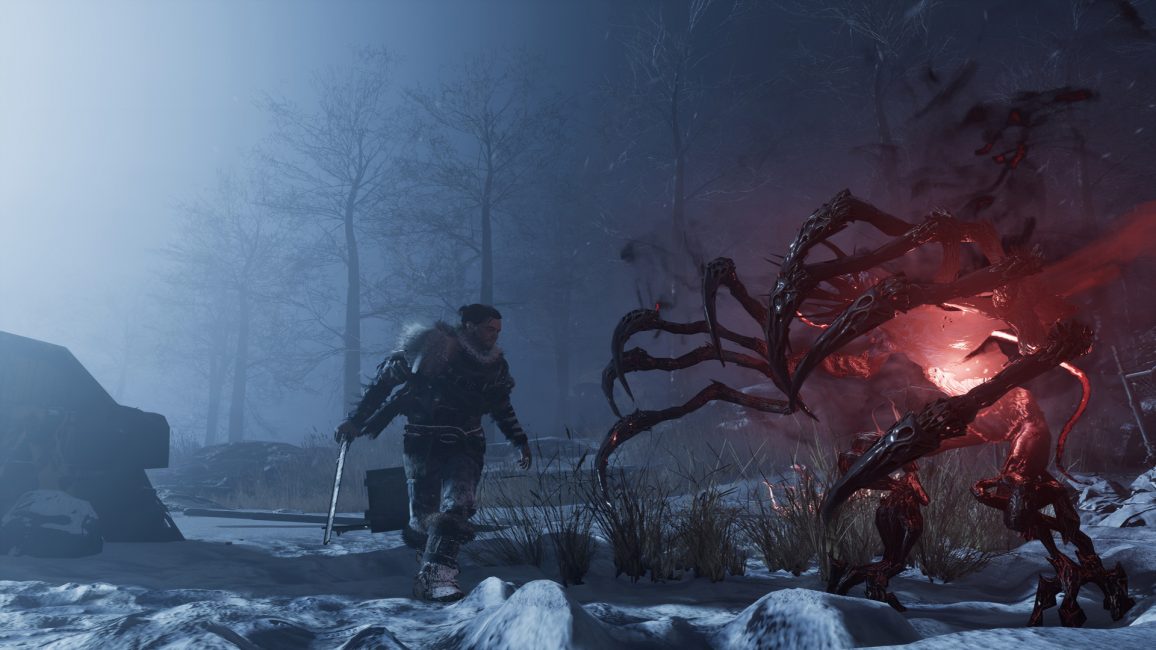Proceduraly generated rogue-like survival games are all the rage these days. Since Minecraft appeared on the scene we’ve seen a flood of them, and for good reason. This combination of factors leads to a seemingly limitless amount of replayability. Every time you start a game the entire world is new, never before seen, making every game a completely unique adventure. That is until you start to see the repetition. Reused assets, entire rooms or parts of environments copy and pasted. Supposedly random characters and events that are suspiciously similar to other random characters and events, except this time they’re blue. Procedural generation can be used to instill a constant feeling of wonder in a player, but can also have the opposite effect when overused. Fade to Silence differentiates itself in sea of proceduraly generated rogue-like survival games by choosing to drop the procedural generation.
I’ve always had a love-hate relationship with rogue-likes, or rogue-lites depending on the level of torture. The few I’ve enjoyed kept me occupied for reasons other than the challenge. Dead Cells has amazing gameplay, and Don’t Starve offers a wacky world to explore, but eventually the constant cycle of death and rebirth in a totally new, unknown world wears thin. For me, procedural generation and rogue-like difficulty doesn’t work because I never feel like I am making substantial progress. In Fade to Silence, however, I could learn the layout of the world because it’s always the same. I could bring that knowledge into every game, making each run a little more efficient and getting me a little further. I some how found comfort in this, despite the fact that the world was constantly trying to kill me.

I first caught a glimmer of hope when I encountered my first NPC in Fade to Silence. NPCs are extremely valuable because you can assign them tasks like collecting resources and building structures. Up until I had found Vic I was making meager progress, but then all of sudden I had a helping hand. This made almost everything a little more surmountable and I felt like I was finally on the right path… Then I died. Now, in Fade to Silence is it possible to acquire multiple lives per run, but eventually those lives will run out and you will have to start all over. I this case, it was back to square one for me.
It’s at this point where I would have turned the game off, never playing it again. Dying in rogue-likes is common, but usually the runs are pretty short. A 20 minute run in Dead Cells, for instance, is an eternity. I had played this “run” in Fade to Silence for 90 minutes then *poof* all gone. That’s a lot of time to flush down the toilet. However, as it started me up at the beginning I realized something: I know exactly where I need to go in order to rebuild. I can also do it more efficiently, not wasting time on fool’s errands or getting into unnecessary fights. So once I was let loose I b-lined it to where I found Vic, saving and recruiting her in under ten minutes, something that took me almost an hour before. I then set her to task collecting wood and building a blacksmith. In 30 minutes I had already achieved what took me 90 last time. It was far more satisfying than I ever thought it would be.

I no longer feared dying because, even though I’d have to retread some territory if I did, it would be well worn territory. I knew what to expect around every corner and where the best resources were. It kept me motivated even though I technically lost everything every time I started again. This formula even had me restarting runs that I may have gotten to a rough start in, something I never do. I began to feel the satisfaction of a “perfect run”, something rogue-likes are supposed to peddle in, but had eluded me for years.
Open world games have always been about giving you a hand-crafted world to explore, but they are also time-consuming and expensive to make. It’s obvious why smaller developers with smaller budgets opt for procedural generation over bespoke level design: more bang for your buck, both for them and the player. But every decision needs to be made accordingly, and sometimes bucking a trend can pay off. Fade to Silence stands out to me because of a seemingly simple decision that made me reconsider my relationship with an entire genre of games. It’s because of this that it won’t fade from my memory any time soon.









